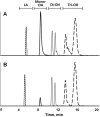Antifungal hydroxy fatty acids produced during sourdough fermentation: microbial and enzymatic pathways, and antifungal activity in bread
- PMID: 23315734
- PMCID: PMC3592247
- DOI: 10.1128/AEM.03784-12
Antifungal hydroxy fatty acids produced during sourdough fermentation: microbial and enzymatic pathways, and antifungal activity in bread
Abstract
Lactobacilli convert linoleic acid to hydroxy fatty acids; however, this conversion has not been demonstrated in food fermentations and it remains unknown whether hydroxy fatty acids produced by lactobacilli have antifungal activity. This study aimed to determine whether lactobacilli convert linoleic acid to metabolites with antifungal activity and to assess whether this conversion can be employed to delay fungal growth on bread. Aqueous and organic extracts from seven strains of lactobacilli grown in modified De Man Rogosa Sharpe medium or sourdough were assayed for antifungal activity. Lactobacillus hammesii exhibited increased antifungal activity upon the addition of linoleic acid as a substrate. Bioassay-guided fractionation attributed the antifungal activity of L. hammesii to a monohydroxy C(18:1) fatty acid. Comparison of its antifungal activity to those of other hydroxy fatty acids revealed that the monohydroxy fraction from L. hammesii and coriolic (13-hydroxy-9,11-octadecadienoic) acid were the most active, with MICs of 0.1 to 0.7 g liter(-1). Ricinoleic (12-hydroxy-9-octadecenoic) acid was active at a MIC of 2.4 g liter(-1). L. hammesii accumulated the monohydroxy C(18:1) fatty acid in sourdough to a concentration of 0.73 ± 0.03 g liter(-1) (mean ± standard deviation). Generation of hydroxy fatty acids in sourdough also occurred through enzymatic oxidation of linoleic acid to coriolic acid. The use of 20% sourdough fermented with L. hammesii or the use of 0.15% coriolic acid in bread making increased the mold-free shelf life by 2 to 3 days or from 2 to more than 6 days, respectively. In conclusion, L. hammesii converts linoleic acid in sourdough and the resulting monohydroxy octadecenoic acid exerts antifungal activity in bread.
Figures


Similar articles
-
Exploiting synergies of sourdough and antifungal organic acids to delay fungal spoilage of bread.Int J Food Microbiol. 2019 Aug 2;302:8-14. doi: 10.1016/j.ijfoodmicro.2018.09.007. Epub 2018 Sep 11. Int J Food Microbiol. 2019. PMID: 30220438
-
Antifungal sourdough lactic acid bacteria as biopreservation tool in quinoa and rice bread.Int J Food Microbiol. 2016 Dec 19;239:86-94. doi: 10.1016/j.ijfoodmicro.2016.05.006. Epub 2016 May 7. Int J Food Microbiol. 2016. PMID: 27236463
-
Propionic acid production by cofermentation of Lactobacillus buchneri and Lactobacillus diolivorans in sourdough.Food Microbiol. 2010 May;27(3):390-5. doi: 10.1016/j.fm.2009.11.019. Epub 2009 Dec 3. Food Microbiol. 2010. PMID: 20227604
-
Enzymatic and bacterial conversions during sourdough fermentation.Food Microbiol. 2014 Feb;37:2-10. doi: 10.1016/j.fm.2013.04.007. Epub 2013 Apr 25. Food Microbiol. 2014. PMID: 24230468 Review.
-
Impact of sourdough on the texture of bread.Food Microbiol. 2007 Apr;24(2):165-74. doi: 10.1016/j.fm.2006.07.011. Epub 2006 Sep 20. Food Microbiol. 2007. PMID: 17008161 Review.
Cited by
-
Biotechnological formation of dairy flavor inducing δ-lactones from vegetable oil.Food Chem X. 2022 Jan 19;13:100220. doi: 10.1016/j.fochx.2022.100220. eCollection 2022 Mar 30. Food Chem X. 2022. PMID: 35498959 Free PMC article.
-
Anti-Spoilage Activity and Exopolysaccharides Production by Selected Lactic Acid Bacteria.Foods. 2022 Jun 27;11(13):1914. doi: 10.3390/foods11131914. Foods. 2022. PMID: 35804730 Free PMC article.
-
Lactic Acid Bacteria in Raw-Milk Cheeses: From Starter Cultures to Probiotic Functions.Foods. 2022 Jul 29;11(15):2276. doi: 10.3390/foods11152276. Foods. 2022. PMID: 35954043 Free PMC article. Review.
-
Limosilactobacillus reuteri as sustainable biological control agent against toxigenic Fusarium verticillioides.Braz J Microbiol. 2023 Sep;54(3):2219-2226. doi: 10.1007/s42770-023-01081-4. Epub 2023 Aug 2. Braz J Microbiol. 2023. PMID: 37531006 Free PMC article.
-
Antifungal Microbial Agents for Food Biopreservation-A Review.Microorganisms. 2017 Jul 8;5(3):37. doi: 10.3390/microorganisms5030037. Microorganisms. 2017. PMID: 28698479 Free PMC article. Review.
References
-
- Salovaara H. 2004. Lactic acid bacteria in cereal-based products, 3rd ed, p 431–452 In Salminen S, von Wright A, Ouwehand A. (ed), Lactic acid bacteria. CRC Press, Boca Raton, FL
-
- Smith JP, Daifas DP, El-Khoury W, Koukoutsis J, El-Khoury A. 2004. Shelf life and safety concerns of bakery products. Crit. Rev. Food Sci. Nutr. 44:19–55 - PubMed
-
- Coda R, Cassone A, Rizzello CG, Nionelli L, Cardinali G, Gobbetti M. 2011. Antifungal activity of Wickerhamomyces anomalus and Lactobacillus plantarum during sourdough fermentation: identification of novel compounds and long-term effect during storage of wheat bread. Appl. Environ. Microbiol. 77:3484–3492 - PMC - PubMed
-
- Ryan LAM, Zannini E, Dal Bello F, Pawlosksa A, Koehler P, Arendt EK. 2011. Lactobacillus amylovorus DSM19280 as a novel food-grade antifungal agent for bakery products. Int. J. Food Microbiol. 146:276–283 - PubMed
Publication types
MeSH terms
Substances
LinkOut - more resources
Full Text Sources
Other Literature Sources
Medical

